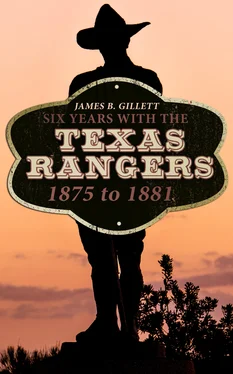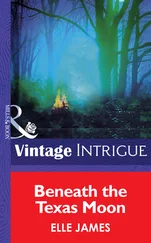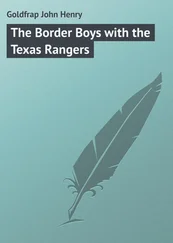James B. Gillett - Six Years With the Texas Rangers - 1875 to 1881
Здесь есть возможность читать онлайн «James B. Gillett - Six Years With the Texas Rangers - 1875 to 1881» — ознакомительный отрывок электронной книги совершенно бесплатно, а после прочтения отрывка купить полную версию. В некоторых случаях можно слушать аудио, скачать через торрент в формате fb2 и присутствует краткое содержание. Жанр: unrecognised, на английском языке. Описание произведения, (предисловие) а так же отзывы посетителей доступны на портале библиотеки ЛибКат.
- Название:Six Years With the Texas Rangers: 1875 to 1881
- Автор:
- Жанр:
- Год:неизвестен
- ISBN:нет данных
- Рейтинг книги:3 / 5. Голосов: 1
-
Избранное:Добавить в избранное
- Отзывы:
-
Ваша оценка:
- 60
- 1
- 2
- 3
- 4
- 5
Six Years With the Texas Rangers: 1875 to 1881: краткое содержание, описание и аннотация
Предлагаем к чтению аннотацию, описание, краткое содержание или предисловие (зависит от того, что написал сам автор книги «Six Years With the Texas Rangers: 1875 to 1881»). Если вы не нашли необходимую информацию о книге — напишите в комментариях, мы постараемся отыскать её.
Six Years With the Texas Rangers: 1875 to 1881 — читать онлайн ознакомительный отрывок
Ниже представлен текст книги, разбитый по страницам. Система сохранения места последней прочитанной страницы, позволяет с удобством читать онлайн бесплатно книгу «Six Years With the Texas Rangers: 1875 to 1881», без необходимости каждый раз заново искать на чём Вы остановились. Поставьте закладку, и сможете в любой момент перейти на страницу, на которой закончили чтение.
Интервал:
Закладка:
"But how do you know it is an Indian trail?" demanded Hawkins.
"Because I know I know," cried out Lynch in a loud voice.
That settled it. Horses were saddled and mules packed as quickly as possible, and the rangers marched over to the suspicious trail. When Sergeant Hawkins examined the trail he soon discovered that the sign had been made by mustangs but could not convince the hard-headed Irishman until he followed the trail two or three miles and showed him the mustang herd quietly grazing under some shade trees. Uncle Mike did not mention Indian trail any more on that scout.
Though we did not find any trails or Indians the scouting party killed two black bear, several deer and about fifteen wild turkey.
Early in September, 1875, Captain Roberts again ordered Sergeant Hawkins to take fifteen men and make a ten days' scout on the Brady Mountains. To my great joy I was detailed on this expedition. When near the head of Scalp Creek, Menard County, on our return trip, the sergeant told the boys to keep a sharp lookout for a deer, as we would reach the San Saba by noon and would camp on that stream for the night. We had not traveled far before Ed Seiker killed a nice little spiked buck. We strapped him on one of the pack mules, and when we arrived at the river we came upon a flock of half-grown wild turkeys. Bill Clements leaped from his horse and killed six of them.
We then camped, hobbled and sidelined our horses and put a strong guard with them. While some of the boys were gathering wood for our fire they found an old elm stump ten to twelve feet high with bees going in at the top. One of the rangers rode over to Rufe Winn's ranch and borrowed an ax and a bucket. When he returned we cut the tree and got more honey than sixteen men could eat, besides filling the bucket with nice sealed honey, which we gave to Mrs. Winn in return for the use of her ax. Then, after dinner, out came fishing tackle and, using venison for bait, we caught more catfish than the entire crowd could eat.
Hunting conditions in those days were ideal. I have known a single scout to kill three or four bears on a single trip. The companies to the north of us were never out of buffalo meat in season. Then, in the fall, one could gather enough pecans, as fine as ever grew, in half a day to last the company a month. I have seen hundreds of bushels of the nuts go to waste because there was no one to gather them—besides they sold on the market for fifty cents per bushel. No wonder that a boy that loved the woods and nature was charmed and fascinated with the life of the Texas Ranger. It was a picnic for me from start to finish, and the six years I was with the battalion were the happiest and most interesting of my life.
But hunting and fishing and vacation scouts were not the sole duties of a ranger. Pleasure was abundant, but there were times when all these were laid aside. For the game guns and the fishing rod we exchanged our carbines and our six-shooters and engaged in hazardous expeditions after marauding redskins. I was soon to see this latter aspect of ranger life, for in the latter part of August, 1875, I became a real ranger and entered upon the real work of our battalion—that of protecting the frontier against the roving Indians and engaging them in regular pitched battles.
CHAPTER IV
MY FIRST BRUSH WITH INDIANS
Table of Contents
The latter part of August, 1875, Private L. P. Seiker was sent on detached service to Fort Mason, about fifty miles due east of our camp. While there a runner came in from Honey Creek with the report that a band of fifteen Indians had raided the John Gamble ranch and stolen some horses within twenty-five steps of the ranch house. The redskins appeared on their raid late in the evening and the runner reached Mason just at dark.
Lam Seiker had just eaten his supper and was sitting in the lobby of the Frontier Hotel when the message came. He hurried to the livery stable, saddled his horse, Old Pete, and started on an all-night ride for the company. The nights in August are short, but Seiker rode into our camp about 8 o'clock the following morning and reported the presence of the Indians.
The company horses were out under herd for the day, but Captain Roberts sent out hurry orders for them. Sergeant Plunk Murray was ordered to detail fifteen men, issue them ten days' rations and one hundred rounds of ammunition each. Second Sergeant Jim Hawkins, Privates Paul Durham, Nick Donnelly, Tom Gillespie, Mike Lynch, Andy Wilson, Henry Maltimore, Jim Trout, William Kimbrough, Silas B. Crump, Ed Seiker, Jim Day, John Cupps and myself, under command of Captain Roberts, were selected as the personnel of the scout. As can be imagined I was delighted with my good fortune in getting on the party and looked forward with intense satisfaction to my first brush with Indians.
The mules were soon packed and by the time the horses reached camp the scout was ready. Sergeant Hawkins, as soon as the men had saddled their horses, walked over to the captain, saluted and told him the scout was ready. Before leaving camp Captain Roberts called to Sergeant Murray and told him that he believed the Indians had about as many horses as they could well get away with, and that they would probably cross the San Saba River near the mouth of Scalp Creek and follow the high divide between the two streams on their westward march back into the plains. If the redskins did not travel that way the captain thought they would go out up the Big Saline, follow the divide between the North Llano and San Saba Rivers westward and escape, but he was confident the band would travel up the divide north of Menardville. He determined to scout that way himself, and instructed Murray to send two rangers south over to the head waters of Bear Creek to keep a sharp lookout for the trail. These two scouts were to repeat their operations the next day, and if they discovered the Indian trail Murray was to make up a second scout and follow the redskins vigorously.
His plan outlined, Captain Roberts gave the order to mount, and we rode toward Menardville, making inquiry about the Indians. All was quiet at this little frontier village, so we crossed the San Saba River just below the town, and after passing the ruins of the Spanish Fort, Captain Roberts halted his men and prepared to send out trailers. Two of the best trailers in the command were ordered to proceed about four hundred yards ahead of the party and keep a close watch for pony tracks while they traveled due north at a good saddle horse gait. The main body of men, under the captain himself, would follow directly behind the outposts.
Our party had traveled about eight or nine miles when Captain Roberts' keen eyes discovered a lone pony standing with his head down straight ahead of us. He sighted the animal before the trailers did, and remarked to us that there the trail was. The outposts halted when they saw the pony and waited for us to come up. Sure enough, here was the Indian trail probably twenty yards wide. Captain Roberts dismounted and walked over the sign, scrutinizing every pony track, bunch of grass and fallen leaf. He then examined the old pony. The animal was cut with a lance, with his back sore and his feet all worn out. It was then between 12 and 1 o'clock, and the captain thought the Indians had passed that way about sunrise, for the blood and sweat on the horse was now dry. The trail showed the raiders were driving rather fast and were probably thirty-five or forty miles ahead of us. The captain decided it would be a long chase and that we would just have to walk them down if we caught them at all.
There was no water on this divide so we took the trail without stopping for dinner. Captain Roberts had a fine saddle horse, Old Rock, and we followed the trail at a steady gait of five or six miles an hour. At sundown we reached the old government road that runs from Fort McKavett to Fort Concho. We were then about twelve or fifteen miles south of Kickapoo Springs, so we turned up the road, reaching the springs late at night. The horses had not had a drop of water since leaving the San Saba that morning, and, facing a hot August sun all day, the men were pretty well tired out when they reached camp, had supper and gotten to bed. We estimated we had ridden about sixty miles since leaving camp. During the day Captain Roberts' horse cast a shoe, so Tom Gillespie shod him by firelight, as it was the captain's intention to resume the trail at daylight.
Читать дальшеИнтервал:
Закладка:
Похожие книги на «Six Years With the Texas Rangers: 1875 to 1881»
Представляем Вашему вниманию похожие книги на «Six Years With the Texas Rangers: 1875 to 1881» списком для выбора. Мы отобрали схожую по названию и смыслу литературу в надежде предоставить читателям больше вариантов отыскать новые, интересные, ещё непрочитанные произведения.
Обсуждение, отзывы о книге «Six Years With the Texas Rangers: 1875 to 1881» и просто собственные мнения читателей. Оставьте ваши комментарии, напишите, что Вы думаете о произведении, его смысле или главных героях. Укажите что конкретно понравилось, а что нет, и почему Вы так считаете.












